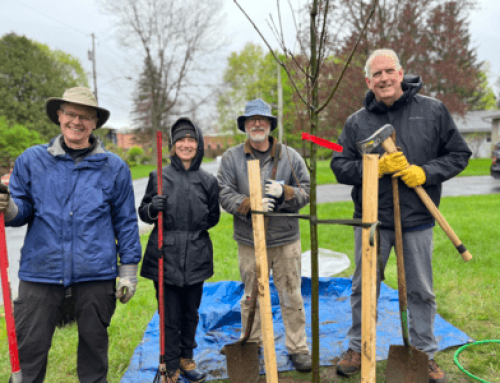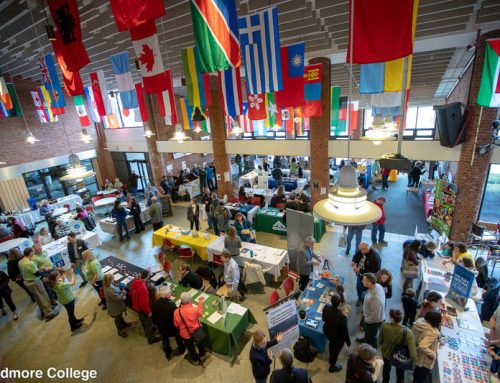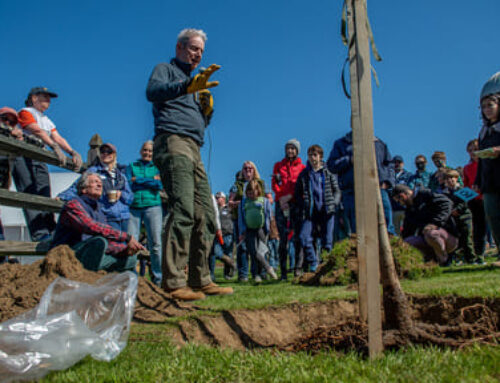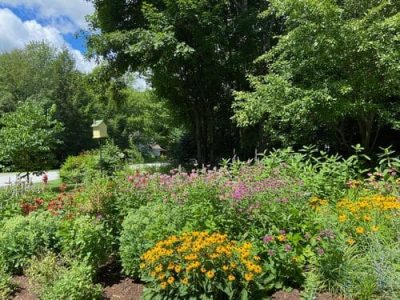
Summber blooms in the Pollinator Garden (photo: Wendy Mahaney)
Photo: Wendy Mahaney
Starting from scratch:
How to create a native perennial pollinator garden
if you have never done it before
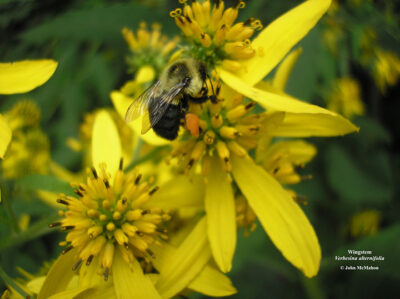
Verbesina alternifolia
We have heard from many people who want to know how to get started with native plant gardening. Although we have talked around this issue before, if you have never planted a garden, some of our suggestions may assume too much basic knowledge. This post aims to tell you how to start a pollinator garden from scratch in and around Saratoga County, New York. The timing and plants will be different in other areas, but the basic principles will be the same.
Pick your spot
If you want to plant pollinator flowers, you need sun. Ideally, the garden should have 8 or more hours of full sun, but I have a garden in the shadow of a building that only gets six hours of full sun and it does just fine. Pollinators and their flower hosts thrive in sun. You can have a nice garden with native shade plants, but it won’t attract as many pollinators as a sunny garden.
Prepare your soil
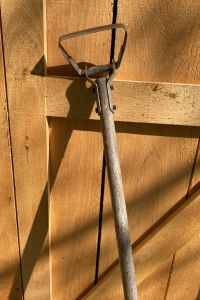
Stirrup hoe
To prepare the earth for your young plants, you need to remove the competition. That is, you have to get rid of the turf grass or other plants that are in the way. The best way that I know of to prepare a garden bed is to use the “lasagna method,” also known as sheet mulching. In the lasagna method you cut down or pull out and discard whatever vegetation is in your future native plant bed, then dig or use a stirrup hoe to disturb the roots that remain in the ground (dig out and throw away big pieces of root so they don’t re-sprout). Once the soil is more or less bare, place a layer of corrugated brown cardboard over the ground where you want your flower bed to be. Black and white newspaper also works, but use several layers. Don’t use glossy magazine inserts or even the funnies – save those for wrapping birthday presents. Place a three- to four-inch layer of high-quality organic compost on top the cardboard. You can make the compost yourself or purchase it from a nursery or a reliable supplier.
Water the bed well. If it doesn’t rain, keep watering the bed so the cardboard will start to break down. Wait six weeks for the unwanted seeds and plant parts under the cardboard to germinate and die. The cardboard will be soft and you can plant your native perennials right into it. Everything under the cardboard will be dead and rotting, perfect for feeding your new plants. The lasagna method is great because it controls weeds while adding aged compost and decomposing plant matter to your garden from the very beginning. It doesn’t matter if you have to delay your planting for six weeks and don’t get your plants into the ground till the end of June or early July – they are perennials, not tomatoes, and will do just fine. You can also plant native perennials in the fall, so if you miss the May-June planting season, prepare your garden bed in late summer and plant into it in September. You can even start a lasagna bed in the fall and wait until spring to plant into it. In that case, don’t bother watering, nature will take care of it.
Pesticides and lawn care
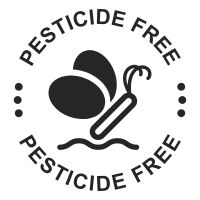 If you have a lawn service that uses herbicides or insecticides, or if you use them yourself on your yard, DO NOT PLANT A POLLINATOR GARDEN. The grubs in lawns that people think they have to spray are beetles. Beetles are insects. The pesticides that kill those beetles will kill your Monarch butterflies and bumblebees. Pesticides drift to nontarget flower beds so any pollinator garden adjacent to a lawn or other part of your property or a near neighbor’s property that gets sprayed will be a death trap for the pollinators that come to your flowers. If you want a pollinator garden, you cannot use insecticides. It is a basic choice that must be made before you start your garden. If you like birds and butterflies, the choice is easy.
If you have a lawn service that uses herbicides or insecticides, or if you use them yourself on your yard, DO NOT PLANT A POLLINATOR GARDEN. The grubs in lawns that people think they have to spray are beetles. Beetles are insects. The pesticides that kill those beetles will kill your Monarch butterflies and bumblebees. Pesticides drift to nontarget flower beds so any pollinator garden adjacent to a lawn or other part of your property or a near neighbor’s property that gets sprayed will be a death trap for the pollinators that come to your flowers. If you want a pollinator garden, you cannot use insecticides. It is a basic choice that must be made before you start your garden. If you like birds and butterflies, the choice is easy.
Plan your garden
My suggestion is to spend several hours on the internet looking at plants available from regional native plant nurseries that supply plants suitable for the Northeast United States (in our case, some of the nurseries may be in Ohio or Pennsylvania, but don’t go too far south or too far west or the plants will not native to our region). This list of Native Plants for Pollinators and Beneficial Insects for the Northeast Region from the Xerces Society is a great place to start. See what looks good to you. Doodle sketches. Learn what kinds of insects are attracted to which flowers. Include common milkweed for the monarchs in your plan. Then be flexible. It is a garden, not rocket science. Your goal is to help pollinators and create something of beauty and interest. Everything else doesn’t matter. And if you make a mistake this year, you can fix it next year. Gardening is wonderful that way; each year is a new opportunity.

Three types of milkweed: Swamp Milkweed, Common Milkweed, Butterfly Weed
In planning your garden keep in mind that large patches of the same flower are easier for pollinators to find and make their foraging more efficient. We tend to want to plant in an orderly fashion with contrasting colors and formal garden patterns. Pollinators prefer big swaths of a single blooming plant species and will switch what they search for a number of times over the course of the season as flowers bloom and fade. If you can tolerate it and have space, plant for the convenience of insects; a full bed of black eyed susans or coneflowers in one part of the garden, a large border of goldenrods and asters in another part, a milkweed patch for the monarch butterflies in August and September. If you don’t want to have large patches, try to use at least three of the same species of plant together rather than using single plants.

Joe-pye weed and Common white snakeroot
Some help with the planning: Prairie Moon Nursery sells native plants and has a fabulous set of filters that can help you plan your garden. You can sort plants by color, height, bloom time, region, and climate zone. In Saratoga Springs, we are in zone 5a. Pick plants that are easy to grow, that interest you, that bloom at different times and that are hosts to both native bees and native butterflies. Some of the best pollinator plants in our region are wood asters, New England asters, lance leaf coreopsis, black eyed Susans, blue lobelia, Joe-Pye weed, woodland sunflowers, blue false indigo, milkweed, mountain mint, native bee balms, native coneflowers, evening primrose and any and all goldenrods.
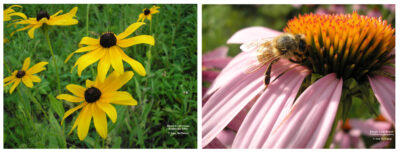
Black eyed susan and Purple coneflower
Consult native plant nurseries and the Garden for Wildlife program of the National Wildlife Federation for ideas. You can also talk to/take a field trip to visit one of our near-by native plant nurseries: Wild Things Rescue Nursery or Catskill Native Nursery. This is an area of growing interest for horticulturalists, so new native plant nurseries may be popping up soon. You can also look at the plant list for Sustainable Saratoga’s Pollinator Palooza native plant sale (heldJune 4) and work some of those plants into your plan since they are well suited for local conditions in our region and were selected because pollinators love them. Finally, download a plant app to your phone so that you can identify flowers you like when you go on nature walks or visit other people’s gardens. Seek is my favorite app for flowers; it tells you whether a plant is native or introduced so it is very useful for garden planning.
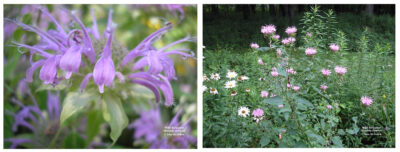
Bee balm
Buying and caring for your native perennials before planting
Be sure you deal only with nurseries or growers that do not use pesticides. If you buy native plants from a big box store, they will probably be treated with neonicotinoids or other harmful chemicals that will kill every insect pollinator that you attract to your garden. Do not buy from them, no matter how reasonable the price. If you are buying plants at the farmers’ market, ask the farmer if the plants are organically grown. If they aren’t, ask them what kinds of insecticides they use on them. If they give you any answer other than, “We don’t use insecticides,” shop elsewhere. And politely tell them why you are not buying from them so that they understand there is a market for insecticide-free bedding plants. It is safer to buy from a native plant nursery on line than from a big box store, a local non-native nursery or farmers who spray their plants with insecticides.
Only buy true native types, not cultivars or nativars. Our local pollinators evolved with our local plants. Although plant breeders may “improve” on those plants, that is, select for traits that are desirable to human gardeners such as unusual colors or extra petals, those traits are usually not as attractive to insects as they are to people. And those special traits may come at a cost to the quality of pollen or nectar or some function of the plant that makes appealing it to insect pollinators. Just say no to innovation.
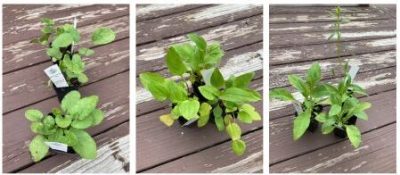
Golden Ragwort, Purple Coneflower, Forest Goldenrod purchased at the Pollinator Palloza plant sale
If you have to wait a while to plant in the ground after purchasing your perennials, water the plants regularly since they dry out quickly in pots. Keep them in the sun outside unless they were greenhouse grown, in which case you should move them over the course of a week or so from dappled shade to full sun. If they aren’t used to direct sun, the intense light can burn their leaves. If that happens, it is not the end of the world, new leaves will grow. It is just better not to set your little plants back before you put them in the ground.
Planting
Dig a hole, put the plant into it so that it is covered up to the same spot on its stem as when it was in the pot. That is, not so deep that part of its green stem is in the ground and not so shallow that the tops of its roots are above the ground. Dig a hole big enough so you don’t have to curl the roots up to get them to fit in the hole. Fill the hole back in and tamp the soil down around the plant with your hands, not your feet. Soil contact is important so you want your plant to be firmly in place but you don’t want to compress the soil too much or trample the plant by mistake.
For spacing plants, look at the information on the Prairie Moon Nursery website or whatever information the nursery where you bought them provided you. Bigger plants need more space between them than smaller plants. Some plants spread easily, give them extra room. Most plants can be moved in the spring or fall if you make a mistake and plant them too closely together, so don’t fret about it. Milkweed may be an exception, it doesn’t like to be transplanted.
Watering
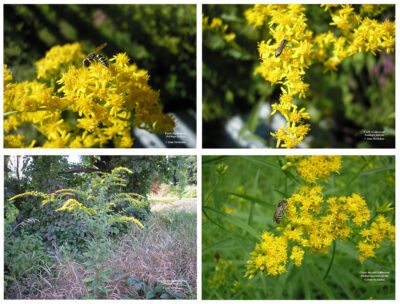
Goldenrods
Water the plants every day for the first couple of weeks unless it rains. As they start to look healthy and grow, you can water less often, but watering at least every other day is important during the first growing season while their roots are establishing. If it is really hot and dry, water every day. Plants build their bodies out of water and thin air; you can help them out with the water part. Learn about photosynthesis and appreciate the miraculous way plants sustain life on earth. We need to eat, they create food for us and everyone else on the planet out of carbon dioxide and water. We need to breath, they emit oxygen and water as waste products of photosynthesis. Amazing, right? Pollinators are not the only creatures that depend on plants for their survival.
Weeding
Just like you need to give your plants bare ground to start out in life, you need to keep down the weeds until they get established. I once heard a farmer say that rather than yank out giant weeds, you should kill the weeds while they are small by tickling the ground weekly with a hoe. This is very good advice. Buy a stirrup hoe, keep it sharp by filing it between uses, and gently move it through the soil around your plants before the weeds get large. If a big weed pops up after you have gone on vacation or is too close to your perennial to use a hoe, you can pull it out by hand, but a stirrup hoe is the right tool for ground tickling. Around year two or three as your native plants grow and spread, weeding won’t be as important, especially if you have a big patch of one kind of plant.
Other Maintenance
Don’t put down wood chips or any other mulch except compost. You can add compost whenever you feel like it and can make the garden look nice with compost “mulch” if you like things tidy. Do not, under any circumstances, ever use insecticides. Don’t use herbicides. Don’t use non-organic chemical fertilizer. Native perennials don’t need much, they are tough northern species. With native plants, less is better. Leave them alone, except for watering, weeding and occasional composting. If a plant lists to the side, feel free to trim it lightly or trellis it or prop it up. And turn off your porch lights at night. Nocturnal insects and birds, as well as virtually all plants, do better with no artificial light. Porch lights, especially LED lights, interfere with wildlife of all kinds. Lights out for wildlife.
Putting the plants to bed in the winter
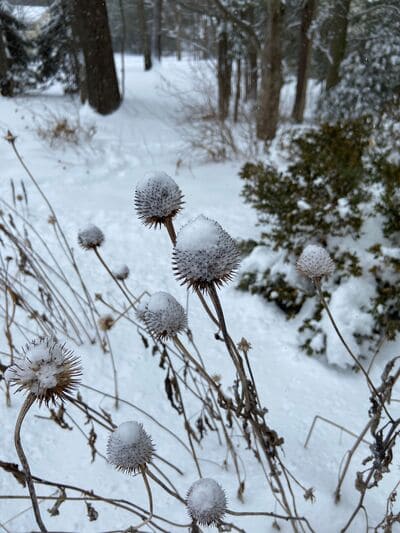
photo: Wendy Mahaney
Don’t. They will be fine. Don’t deadhead the flowers or cut the stems down, leave them to be shelter and food for the small creatures living their lives in your yard. Don’t rake the leaves from the beds, they provide minerals and nutrients to your plants for free and are excellent overwintering substrate for fireflies. The plants will emerge through the leaves in the spring. Don’t put down wood chip mulch or other weed-smothering devices. Ground bees and bumble bees need bare ground for their nests and can’t penetrate wood chips. Whenever you think of an intervention to do in your native plant garden in the fall, go take a nap instead. In the spring, water again as needed, weed again as needed and maybe add some more compost. Fill in any gaps with new plants or, better yet, kill some more of your lawn and make your native plant bed bigger.
The nice thing about perennial native plants is that the conditions here are right for them and they are not as fussy as exotic plants that would really prefer to be on the heath in Scotland or on a warm grassy plain in China or something. They belong here, they can take care of themselves once they are in place. The insects recognize them and they continue their long evolutionary dance together. Right in your yard. You have a front row seat.
Resources
See our Pollinator and Native Plants pages for information and resources
Get info on Composting from our Zero Waste committee


